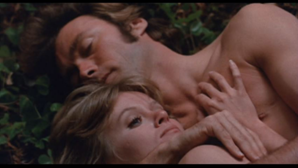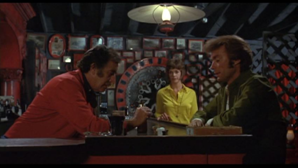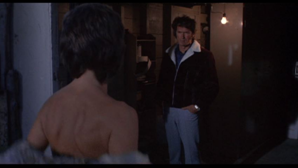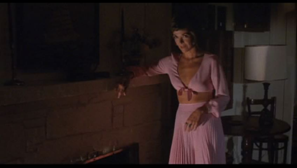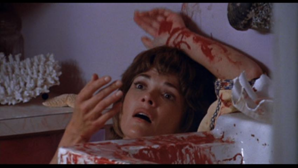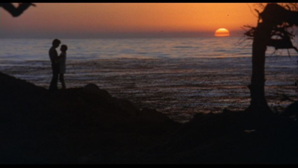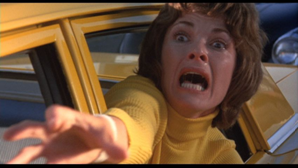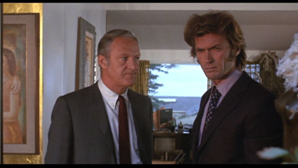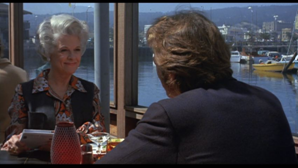West of Eden: Eastwood’s Silent Generation Warning to California in Play Misty for Me (1971)
by Duncan Pittman
A tall, brooding man stands on a cliff overlooking the Pacific Ocean. Waves crash violently against the rocks below, as gnarled cypress trees sway in the cool sea breeze and an ominous mist envelops the settlement built on the edge of the world. Up the coast in San Francisco, a cultural wave was crashing, and the dirty backwash from a momentous generation riding the crest of that wave began to pollute the California shoreline. The man peers over the edge of the cliff and watches in horror as the waves splatter onto the rocks lining the seaside village of Carmel, invading a secluded vista that normally resembles Paradise. In the distance, the tinkering, haunting notes of Errol Garner’s “Misty” float across the water, as the man’s mind drifts back languidly to a simpler time, to the days when the sea was calmer, the night air was warmer, and the beach was more secluded. The man gazes at his reflection in the water as the body of a woman floats by, another casualty to the cultural undertow. The year is 1971. The man is Clint Eastwood. The film is Play Misty for Me.
As Clint Eastwood’s directorial debut, Play Misty for Me has garnered much discussion from cinema scholars, Eastwood fans, and critics alike. The film tells the story of Dave Garver (Clint Eastwood), a laid back jazz radio disc jockey in Carmel, California who becomes the target of harassment and violence after a series of casual sexual encounters with a sexy, but sadistically obsessed fan, Evelyn Draper (Jessica Walter). After her bizarre behavior causes Dave to reject her advances, she proceeds to stalk and physically threaten him and other innocent citizens of the tight-knit Carmel village. Most scholarship on Misty centers on gender and/or genre, addressing the film’s connections to sexual politics, the feminization of the Eastwood persona, and—as Gail Jardine refers to it in her essay “Clint: Cultural Critic, Cowboy of Cathartic Change”—the film’s status as “the grandmother of all Fatal Attraction films.”[1] In his 1993 essay “The Dialect of Female Power and Male Hysteria in Play Misty for Me,” Adam Knee positions the film as a response to 1960s/70s shifts in gender roles, and centers on the notion that Eastwood’s position as the victim in a slasher/stalker narrative reflects men’s anxiety about their inability to control women’s action. For the Man With No Name, Dirty Harry himself, to fall victim to an uncontrollable woman is a hysterical horror indeed. Linda Ruth Williams in The Erotic Thriller in Contemporary Cinema, traces the birth, development, and evolution of the erotic thriller film genre, and considers Play Misty for Me to be one of the prime examples of the sex thriller and precursor to neo-noir films, a complicated heritage of films in which “unstable women… take their sexual rights too seriously.”[2] Williams considers the film alongside other New Hollywood films that offer postmodern updates of classic genre cinema.
Though these analyses offer compelling interpretations, they overlook the other main player in Play Misty for Me: California. As Margaret Crawford notes in her essay “Alternative Shelter: Counterculture Architecture in Northern California,” (2000) “the sixties generation was not the first in California to try to reinvent its relationship to the world. For more than a century, there had existed ‘a California of the mind,’ a vision of the state as a site of liberation and opportunity, a place where Americans could search out new values and ways of living.”[3] It was a generation that, like many before and after it, questioned its elders’ values and assessed the world around it. When we consider the significance of the film’s time and place, we recognize that in addition to challenging norms of gender and genre, the film serves as a warning to California about the excesses of the Sixties, critiquing the countercultural ideologies that threatened California’s idyllic existence.
This essay will consider how the three successive “generations” outlined in William Strauss and Neil Howe’s groundbreaking book Generations: The History of America’s Future, 1584 to 2069—the G.I. Generation, the Silent Generation, and the Baby Boomer Generation—provide a framework for understanding the film’s conflicts in historical terms. Sociologists Strauss and Howe’s dense and detailed work builds upon the work of previous historians who have recognized the significance of generational change or generational rhythms. Strauss and Howe go beyond merely making “general references to the rejuvenative nature of social change,” and instead consider how generations reflect specific underlying currents of their historical context.[4] The G.I. Generation, born between 1901 and 1924, fought in World War II. They were America’s heroes, “fearless but not reckless,” “men’s men” who knew “how to get things done.”[5] They were a generation of John Waynes, Jimmy Stewarts, Charles Lindberghs, John F. Kennedys, and Supermen. They were a “left-brained generation” that failed to see eye-to-eye with their children, the Boomers.[6] The Silent Generation, born between 1925 and 1942, were “the generational stuffings of a sandwich between the get-it-done G.I. and the self-absorbed Boomer.”[7] They lacked an identity of their own and therefore emulated what they saw in G.I. Generation adults, whom they looked to as role models. The Boomers, born between 1943 and 1960, were the “antithesis to everything G.I.: spiritualism over science, gratification over patience, negativism over positivism, fractiousness over conformity, rage over friendliness, self over community.”[8] They are also known for being the most “self-absorbed” generation in American history.[9]
Many films of the “new Hollywood” played out the generational conflicts that haunted America in the wake of the tumultuous postwar years. In 1971, America was still embroiled in the Vietnam War while other countries were withdrawing their forces. Much of the turbulent Sixties had come and gone, as had the protests, demonstrations, and assassinations. The hippie movement had risen and fallen in San Francisco, but not before spreading its critiques of American society across the entire country, leaving America to deal with the aftermath. The 1969 film Easy Rider had been a battle cry for the counterculture movement and a stinging indictment of an intolerant society. A year later the film Joe would come out against the counterculture, speaking for the so-called silent majority. Play Misty for Me is directed from a distinctly Silent Generation point of view, as Eastwood was born in 1930, right in the middle of the generation. Eastwood’s infamous Dirty Harry—also released in 1971—similarly reflects a Silent Generation point of view, positing Eastwood (Harry Callahan) as the one-man vigilante who has the common sense and strength to eradicate the crime and psychotic tendencies of the counterculture. The films serve as compelling counterparts—they each represent a Silent Generation crisis of action, and they require the viewer, like the protagonist, to question the appropriate means of action.
Not a western, yet set in a contemporary “wild west,” Play Misty for Me offers a complex and compelling instance of this vigilante narrative. After the wave of violence caused by Evelyn crashes, one senses that the sleepy town of Carmel will never be the same. As such, location is an indispensable component of Eastwood’s commentary. The film reflects an acute awareness of the cultural tectonic shifts happening beneath the surface of the golden state in the late 60s and early 70s. In the wake of assassinations, race riots, protest demonstrations, rock concert devastations, cultish mass murders, and mounting Vietnam casualties, complaints of “bad vibes” grew chronic, tempers flared, and the streets burned. Residents of the Golden State longed for a time when California meant something idyllic and Edenic. Eastwood’s film reflects a nostalgia for that lost Eden, depicting Carmel, California as a lush, picturesque and romantic utopia that is finally, and irrevocably, marred by Evelyn’s intrusion.
One anonymous Variety staff writer first criticized the film as “an overdone travelogue for the Monterey Peninsula-Carmel home environment of star, producer and debuting director Clint Eastwood,” but he/she also credited the film’s setting in such a locale with effectively conjuring the film’s message of “danger in paradise.”[10] Indeed, it would not have rung as true, had the story been set in a larger metropolis such as Los Angeles or San Francisco. Eastwood intentionally sets his story primarily in the village of Carmel, a place naturally rustic, dramatically beautiful, and comfortably isolated from the rest of the world. It is also a location that, like the lovers’ lanes, rural highways of the Zodiac’s Northern California, and the all-too-private nooks of the Hollywood Hills and the infamous Cielo Drive, lends itself topographically and in terms of settlement to a unique isolation and potential vulnerability. The Monterey Peninsula jets off the central coast of California, on the tip of the edge of the farthest-reaching western boundary of California. It goes to the literal cliff’s edge of the map, of the notion, the spirit, of California.
Roger Ebert’s review pins the film’s success on Eastwood’s own understanding of his on-screen persona and his skillful self-direction, but also emphasizes the importance of setting in accomplishing the film’s “almost cruel efficiency.”[11] He notes the “accumulation of terror” that is achieved by the film’s daytime gloom, writing that “even the ordinary, daytime scenes seem to have unspeakable things lurking beneath them.”[12] Indeed, the film’s depiction of California remarkably conveys both dream and nightmare, making it the perfect setting for a disturbing perversion of the American dream.
Seen as a place of endless possibility, a place not only for new beginnings but for self realization and a sense of belonging, the region had become the place of hopes and dreams, a place that Californian Joan Didion astutely described as “a place in which a boom mentality and a sense of Chekovian loss meet in uneasy suspension; in which the mind is troubled by some buried but ineradicable suspicion that things had better work here, because here, beneath that immense bleached sky, is where we run out of continent.”[13] As such, the popular image of California as a last stop land of redemption and rebirth tends to engender certain desperation in those who seek it out. It is a mentality that endures in the American consciousness. In Slouching Towards Bethlehem, Joan Didion famously describes this cultural shift, reflecting upon her life as a native Californian who returns to her home state to encounter a land she recognizes but no longer knows intimately. A sense of Silent Generation unease, yet inaction, permeates her wizened response to her homeland: “It was not a country in open revolution. It was not a country under enemy siege. It was the United States of America…a great many articulate people seemed to have a sense of high social purpose and it might have been a spring of brave hopes and national promise, but it was not, and more and more people had the uneasy apprehension that it was not. All that seemed clear was that at some point we had aborted ourselves and butchered the job.”[14]
It is this very compacted sense of loss and failure that Eastwood seeks to explore in Play Misty for Me. In choosing Carmel, he has taken as his setting the distilled essence of the original California, that place in which some Edenic purity might still exist. It is fitting, then, that Carmel stands in as the symbol for America’s innocence. The only traces of the modern world encroaching on the secluded paradise of Carmel include the nearby highway, Dave’s sexy playboy convertible, and the eclectic arts-and-crafts bungalows that pepper the cliffs. As the film begins, the camera traces the coastline to Eastwood’s Dave, a tall handsome man in dark sunglasses, exuding “California cool” as he zooms down the coastal highway in his sleek black convertible, blaring rock music as his shaggy blonde hair and hip sideburns tousle in the sea breeze. Initially, the audience is led to believe that this film will be like any other “California” film, a familiar image that serves as misdirection so he can tell us a far deeper, darker story.
Moreover, the easy-going and naturalistic setting of Carmel forms the audience’s perception of the characters that inhabit it. For instance, the relationship between Dave and Tobie, though complicated both by Tobie’s “revolving door” of roommates and Dave’s “hang up” of continual promiscuity, is presented as surprisingly healthy, if not natural. This is reinforced visually by the fact that nearly all of their interactions take place among the natural beauty of the Peninsula’s untouched shoreline. There is rarely an instance in the film where they interact indoors or in other man-made settings. In fact, the only love scene between Dave and Tobie in the film occurs not in a bed, but in the woods on a bed of clover. They are the Adam and Eve of America’s Eden, a bohemian Ken and Barbie.
Likewise, Dave and Tobie’s mutual efforts at being open and honest in the hopes of repairing their relationship demonstrate that their unconventional approach to romantic love, though complicated, is uniquely theirs and, for them at least, represents a natural state of being. Their interaction is easy and comfortable, even when they discuss subject matter such as Dave’s past affairs. All of these elements coalesce to suggest a “natural” fit that the two are in some way destined to be together. Though Tobie and Dave are unmarried and seem unconcerned with the stereotypical American dream of marriage, kids, and a house in the suburbs, neither are they pleasure-seeking, hedonistic counterculture advocates, thumbing their nose at the Establishment.
Nevertheless, it is precisely that hedonistic, hippie stereotype of the counterculture that Evelyn must have had in mind when she headed west and settled in Carmel. Just as Dave and Tobie are thoroughly complicated and individual characters with real depth in the film, Evelyn is to an equal extent anonymous. In fact, the only clue the audience is given about her life before attempting to seduce Dave Garver is a mention of having gone to grade school in Albany, New York. Other elements of Evelyn’s character are either non-descript or suggestive of a more symbolic position, such as her constant references to drinking Coke, a beverage that has long been a symbol of America to the rest of the world. This lack of character development denies personal history as an explanation for Evelyn’s behavior and instead suggests larger societal trends as its source. Thus, Evelyn becomes symbolic of the anonymous and lost outsider, the wandering American anxious to experience the California Dream and reinvent herself.
Furthermore, Evelyn’s character is undeniably associated with other unstable, dark souls who exploited the cultural shifts of the era, violently perverting the open, hippie counterculture for their own psychotic ends. The Manson family murders took place in Los Angles in August of 1969, and the trial ran throughout 1970-71; and the “Zodiac killer”—whose identity remains unknown to this day—committed serial murders throughout the San Francisco area in the late 1960s and early 70s. These horrific events irrevocably changed this era in which hitchhiking and befriending strangers was common practice. The Manson Family Murders and the unknown identity of the Zodiac Killer lurked in the public’s collective consciousness and undoubtedly in that of Eastwood and other Californians. These crimes were particularly unsettling because the victims were going about their everyday lives, relaxing at home with friends, and were butchered by strangers. The crimes didn’t result from too-laid-back Californians opening their doors to bad elements. This was no party gone wrong or societal punishment for decadence. Rather, the crimes resulted from bad elements barging in, uninvited, on California and everything it stood for.
The violent result of Evelyn’s inability to reconcile the new counterculture ideology with traditional American values in Play Misty for Me is mirrored not only by the Manson Family Murders and the Zodiac Killer, but also in the tragic murder of a concert patron at the Rolling Stones’ Altamont Free Concert in 1969, outside of San Francisco. Just four months prior, the Woodstock Music and Art Fair, billed as “3 Days of Peace and Music,” symbolized for many the possibilities of the counterculture idealism, with an estimated 450,000 people coming together in social harmony. But after one of the Hell’s Angels (hired as a security guard) stabbed to death a concert-goer who wielded a gun, Altamont began to symbolize something very different than Woodstock.
Like Evelyn’s violent rampage through Carmel, these events symbolize the end of communal openness, free love, and social harmony promised by the hippie subculture. Evelyn came to Carmel armed with certain notions about the current liberated state of California society, and she adjusted her outward behavior in order to fit in. Thus, in her attempts to seduce Dave, with whom she is obsessed, and in her continual calls to request the 1950s jazz standard “Misty,” she presents herself as the new, sexually liberated female whose interest in a one night stand equals that of the male and whose desire for the trappings of marriage and convention are equally lacking. Throughout the course of the film, however, it becomes shockingly evident that Evelyn’s words and actions rarely match up.
At times, Evelyn appears to be the epitome of the easy breezy chick, hip to the new casual social scene. Initially, it is she who pursues Dave, orchestrating a “chance” meeting at his favorite watering hole, though she lets him think that he has picked her up.
Later that evening at her seaside cottage, Dave reveals that he is “kind of hung up” on Tobie, and that he is not interested in complicating his life. “But that’s no reason we shouldn’t sleep together tonight if we feel like it,” Evelyn seductively replies. In doing so, Evelyn has suggested to Dave that she understands his lifestyle and wants nothing more from him than sex. Likewise, the next day, she shows up uninvited to Dave’s cliffside home. She informs him that she has come back for “seconds,” which he happily indulges in despite his initial protests at the unannounced intrusion. Later, in a more drastic effort to appear sexually liberated, Evelyn appears outside Dave’s home late at night and unabashedly drops her fur coat revealing her naked body, a dramatic response to his refusal to let her inside.
Clearly, Evelyn has assumed that Dave—the hip, artsy California guy that he is—surely must be into free love and an open living environment where no invitation (or dress code) is necessary. Her attempts to adopt the relaxed and bohemian image of the Baby Boomers are often confused and ultimately overwhelmed by her Silent Generation-conditioned tendencies towards marriage and a more traditional approach to courtship. For instance, when she barges in on Dave for “seconds,” she comes armed with a bag of groceries, ready to cook him dinner, having already sized him up as a “steak and potatoes” kind of guy.
This event, combined with a future “date” that she attempts to plan for Dave, which also involves cooking for him, reveals that Evelyn is still operating under the old-fashioned assumption that the way to a man’s heart is through his stomach. Throughout the course of the film, Evelyn frequently puts herself in the subservient role, one that quickly dissolves into a clingy, needy mess. She constantly calls Dave, stalks him, and shows up uninvited, attempting to guilt him into another “date.” Likewise, her constant request that he play the song (their song) “Misty”—a throwback to the 1950s lovelorn, puppy love anthems sung by the likes of crooner Johnny Mathis et al— plays like a twisted serenade ritual. Aside from their casual sexual encounters, it is the only real connection that they share in reality. In perhaps the most telling scene, Evelyn arranges a “date” (one which Dave never actually consented to) for which she cooks an elaborate dinner, dons a brand new pair of “lounging pajamas” (a frock that recalls old Hollywood glamour), and presents Dave with a pair of white leather loafers—a gift more Jerry Lewis than Miles Davis—as an awkward love gift. When Dave arrives, she carefully poses herself by the fire as “Misty” plays on the stereo. Despite Dave’s objections, she sits at his feet, opens his present for him, and verbally degrades herself to geisha status, she who must “remove master’s honorable shoes”
These are hardly the dating habits of the newly liberated counterculture. On the contrary, they hearken back to the 1950s, when both Evelyn and Dave would have been in their dating prime. Evelyn’s view of the new ideology of sexual freedom is merely a charade acted out as the way to steer her relationship back to a comfortable, ritualistic Silent Generation conventionality. This is revealed when Evelyn laughs at Dave’s attempts to keep their sexual relationship casual. “Dave, you’re funny,” she says. “If you want to keep playing these games, okay, but they’re not really necessary anymore…not for me.”
Ultimately, the disparity between Evelyn’s uneasy adoption of new Boomer ideologies and her own, more traditional Silent Generation tendencies cause her a great deal of pain and confusion. This is apparent in her frequent violent outbursts, which always occur after Dave has reacted negatively to her aggressive attempts to establish their relationship. On several occasions, she explodes at strangers in public, screaming such detracting offenses as “Get lost, assholes!” and “Go screw yourself!”
These outbursts reach their peak when Dave attempts to put an end to his “relationship” with Evelyn once and for all. While she plays the geisha and attempts to remove Dave’s shoes, he finally snaps and harshly confronts her. She is distraught, wrongly assuming that they were in love. Dave responds, “I never told you that I loved you.” Evelyn becomes incensed and, not ready to face this direct contradiction to her delusions, screams back at him. “What am I supposed to do?” she yells, “Sit here all dressed up in my little whore suit, waiting for my lord and master to call?” Dave scrambles to escape Evelyn’s clutches and offers a cursory “So long,” to which she explodes. At last, the failure of all of her attempts, both Boomer and Silent, to land Dave have led her to an ultimate break in her “easy breezy” charade.
What follows gets at the heart of Eastwood’s warning to a nation that is quickly, and perhaps unknowingly, adopting aspects of the new Boomer rebellion. Evelyn becomes physically violent, first towards herself and then towards others. After a suicide attempt orchestrated to gain Dave’s sympathy, Evelyn turns her confused rage outwards, first destroying Dave’s house and then nearly killing Birdie, his maid and friend, when she happens to walk in on Evelyn’s rampage. By the end of the film, Evelyn has killed Sergeant McCallum and violently attacked both Dave and Tobie, shattering the innocence of America’s Eden. Eastwood’s vision of America’s future as it struggles to integrate the new and radical Boomer ideology is one of confusion, frustration, and danger.
Evelyn’s misunderstandings about contemporary California culture are understandable, particularly given the widespread media coverage of the turbulent events of the previous decade. Perhaps most significant to her impression of Carmel is the “hippie” movement, which took San Francisco’s Haight-Asbury district as its center. Writing in the Annals of the American Academy of Political and Social Science as early as March of 1969, Dr. John Howard described a type of hippie he called “the plastic hippie” in his article “The Flowering of the Hippie Movement.”[15] This “plastic hippie” is differentiated from other hippies by his surface understanding and adoption of certain aspects of hippie culture, mainly as a fashion or fad.[16] Howard states that “by the spring of 1968, the plastic hippie was common in the land, and leather shirts and trousers sold in Haight-Asbury shops for more than $100.”[17] Thus, it is clear that the imagery of the hippie movement spread quickly throughout the country. But its effects were not merely limited to fashion, the bohemian ideology that was central to the hippie movement and thus a part of the media’s coverage. The flood of people from all over the country to San Francisco in the mid to late 1960s and the accompanying adoption of certain hippie fashions and ideologies clearly indicate a widespread influence over the entire country. Prophetically, at the end of the article, Howard argues that the powerful social commentary offered by the hippies will not likely revolutionize “straight” culture, but will very likely change it in subtle and as yet unknown ways.[18] Evelyn certainly appears to embody a member of America’s largely “straight” or mainstream culture that has come to California armed with certain surface understanding of counterculture ideology and ethos. The uneasy mix of these new ideologies with those traditionally held by larger society certainly proves confusing for Evelyn as she attempts to navigate a “new California” that she, until now, has only heard about through the media.
Clint Eastwood’s warning about the dangers of excess and the negative repercussions of the revolutionary Sixties comes from a distinctly Silent Generation point of view. In fact, Eastwood was 40 years old when he directed and starred in Play Misty for Me, too old to be a generational participant in the young counterculture, yet too old to be a part of the G.I. Generation that they were rebelling against. The character of Dave Garver is actually a mix of both Baby Boom Generation and G.I. Generation traits. From the Boomers, Dave takes his sexual promiscuity, his insistence on keeping his personal freedom. He always derides Tobie for her endless roommates, but never once offers to have her come over to his place. Likewise, his job as a jazz radio disc jockey is far from a stuffy 9 to 5, suit-and-tie job, and one that garners him a position of local fame. From the G.I. Generation, he takes his recognition as a member of society, his civic-mindedness and respect for his neighbors, his steady—albeit unconventional—job, his career aspirations, and his home and car, both possessions that he has worked hard for. Thus, like most Silents, he shares qualities of each book-ending generation (always the mediator); but unlike most Silents, he is not preoccupied with marriage and kids as the trappings of a successful adulthood. Tobie is equally moderate. Despite her status as a breezy beach artist who thinks nothing of taking in new roommates or “splitting town” for a few months to regroup in Sausalito, she’s practical and grounded in that she has a job as a professional sculptor in a local gallery and is realistic about the payments she must make in order to keep her house. The Boomer in her comes out in the details, such as her occupation as an artist and her casual attitude towards taking in a string of roommates, often whoever can help pay the rent. Dave warily suggests that Tobie’s home “should have a revolving door.”
Just as Tobie and Dave’s relationship is shown as natural, so is it shown as a compromise between the G.I. (and Silent) emphasis on marriage and the Boomer’s promotion of anonymous free love. Tobie (who is also representative of a newly liberated woman) seems to want to both be with Dave and to continue with her art. For Tobie, wanting Dave does not mean that she wants him as a husband, but rather that he agree to be monogamously committed to her. Never is there mention of them moving in together, marriage, or hypothetical offspring. Their biggest concern is that Tobie’s house be as equally accessible so that they have some place to be alone together. Tobie wants Dave to uphold his laid-back, California-bachelor lifestyle and maintain his local celebrity identity, but she wants him to lose his pesky promiscuous streak—“groupies” and all. Dave, who admits that he has not “exactly been voted monk of the month” by any means, is also ready to start over with Tobie. Despite his past, Dave is ultimately seeking a stable, committed relationship with her. What they really want is G.I. stability with Boomer idealistic commitment.
Through this California-grown, Silent Generation compromise of old and new, Eastwood is suggesting that it’s okay to live an alternative lifestyle, and that this should not be confused with the reckless, über-liberated mentality that is so often attributed to the darker side of the Sixties. This alternative lifestyle works fine in communities such as Carmel where the “ground rules” of a more casual and open nature are agreed upon. This is evidenced by the pre-Evelyn Carmel shown at the beginning of the film. However, Eastwood suggests that this lifestyle cannot exist when it is vulnerable to outsiders who do not understand and may even seek to exploit it. This point is apparent by the end of the film after Evelyn’s violent rampage, one that was accomplished by Evelyn’s intimate access to Dave’s and Tobie’s tendency to take in anonymous roommates. After Dave punches Evelyn, banishing her from paradise, the weary Tobie and Dave limp away to a Carmel that will never return to its former Edenic state.
What Eastwood presents is a situation in which a misguided minority is capable of spoiling things for the majority, a familiar notion at a time when the Manson Family dressed, lived, and acted like L.A-area hippies, but were actually mass murderers. Such cultural costuming reminded the country that looks can be deceiving and trust should be earned. Evelyn embodies the aggressive confusion and frustrations of Boomer Generation selfishness. Her wrath represents an aggressive spirit invading what is supposed to be peace and love. Evelyn arrives in paradise pretending to be hip, current, and warm. When she doesn’t fit in with the natural ease of Carmel, however, she goes crazy and exploits the freedom in order to destroy Dave and Tobie and their situation, even verbalizing her didain for their open relationship.
When she becomes Tobie’s umpteenth anonymous roommate under the alias “Annabel”—a cryptic reference to a love-obsessed Poe heroine—and sinisterly reveals to Tobie that she knows Dave, Evelyn speaks for all members of the darker elements who exploit the innocence and openness of the culture by saying, “God, you’re dumb.” This, then, is Eastwood’s subtle way of warning the Boomer Generation to be more cautious, and that their casual and open acceptance comes with a great deal of vulnerability.
Furthermore, Evelyn’s attack on Birdie, Dave’s black maid, can be seen as symbolic of the ability of a few misguided individuals to wipe away the gains made by disadvantaged groups in the new progressive cultural climate. Her role, however, can also be read as an “art imitating life” reference to Winifred, the black female domestic who worked at Cielo Drive, and who infamously discovered the bodies on the morning of August 9, 1969. Eastwood is concerned, however, not only with the shortcomings or missteps of the Boomers, but also with the Silents. After she is attacked, Dave looks at Birdie in horror, cursing himself for his failure to protect those most vulnerable to the potential failure of the liberal, progressive cultural changes. He failed her because he took too long to fix things. His ongoing Silent Generation attempts to mediate and talk things out allowed the dangerous situation to go too far and gave Evelyn the freedom to victimize an innocent bystander.
Similarly, when Evelyn murders Sergeant McCallum toward the end of the film, it is symbolic of the Boomer culture officially executing the G.I. Generation’s attempts at preventing or squelching the Boomer’s aggressive seizure of liberty and freedom. Throughout the film, the G.I. Generation is portrayed as the most cautious and action-oriented of the three. After the attack on Birdie, it is Sergeant McCallum who attempts to step in and fix the situation. As a member of the G.I. Generation, his slicked silvery-white hair and square-jawed judgment suggest both concern and disappointment regarding Dave’s promiscuity and intimate involvement with someone who is “practically a stranger,” yet has a key to his front door. The conversations between the G.I. McCallum and the Silent Dave play out like a father reprimanding his son for getting carried away and acting recklessly.
Eastwood’s boyish frustrations are palpable, as if he desires to both stand up to and be accepted by the G.I. Generation. The G.I. Generation Sergeant McCallum struggles to understand the Silent Generation’s Boomer affectations in this scene. He is amazed that Dave would let someone get so close to him and know nothing about her. As a member of the G.I. Generation, McCallum recognizes the danger in the world and asks the question that Dave clearly failed to ask himself. McCallum is more guarded and protective, perhaps to the extent that Dave and his fellow Silents seduced by aspects of the Boomer Generation should be. He often steps in to help, which Dave both appreciates and resents. “Now look, do you want to help find her, or would you rather just sit there and bellyache?” McCallum barks to Dave, who pouts at his victimization by Evelyn. “You will change the locks, huh?” McCallum adds, a reminder to the absent-minded Silent youth who has yet to change his open, Boomer ways, despite being stalked by a psychopath.
This scene is revealing for the fact that despite McCallum’s previous warnings, Dave has done nothing to protect himself and now Evelyn has come back. To the G.I., it is common sense to change your locks after a violent attack, but for some reason, this has not occurred to the morally relative Silent. Perhaps most revealing is the pronoun usage at the end of the scene. McCallum mentions “we” in the hopes of catching Evelyn in time, whereas Dave references the same event using the word “you,” as if he has no intentions of being active in the solution to his own problems. He expects the G.I. to take care of that for him. When Evelyn’s wrath steadily grows out of hand, Dave fears for Tobie’s safety, but does not want to draw any more attention to her by being around her. McCallum, as usual, arrives to save the day. “If it’ll make you feel any better,” McCallum offers, “I’ll go over and check your girlfriend’s house myself. Okay?” As if speaking to his father, Dave replies, “I’d sure appreciate that.” Like the good Silent he is, he allows the “get it done” G.I. to step in and solve his problems for him. Being a Silent, however, he also admires the G.I. Generation’s heroism and feels guilty for not fighting his own battles. When Dave thanks him, McCallum humbly refers to himself as a “public servant,” and winks at Dave, à la Superman, as a sign that everything will be okay.
In this scene, McCallum again comes across as a benevolent father and protector to the boyish Dave. The real change in this final interaction between Dave and McCallum is Dave’s change of tone from annoyed to appreciative of the guidance and help offered by the older generation. It is Eastwood’s way of saying that all police are not “pigs,” that some are actually out to serve and protect.
When Eastwood’s Silent Generation methods of mediation and conversation fail to control Evelyn’s psychosis, Eastwood resorts to physically assaulting her with a classic American punch that sends Evelyn sailing over the balcony and into the rocky waters below. The Boomer mentality has created the horrible situation, the solution to which is the straightforward G.I. approach. Yet, Eastwood has Evelyn kill of the G.I. cop, forcing Dave to step in and take care of his own troubles, thus redeeming the Silent Generation and passing the torch of instruction on how to mediate (with force) law and order in an era of revolution, cultural turmoil, and vulnerability. It is now up to the Silent Generation to help guide the Boomers and mediate the excesses of their generation. If the Boomers won’t listen to their fathers, they’ll at least now look to their big brothers to stick up for them and guide them in how to be men.
Eastwood’s portrayal of the G.I. Generation is not merely limited to that of protector, however. Don Siegel, his real-life friend and mentor (who directed Eastwood’s performances in American westerns and would go on to direct him in Dirty Harry later that year), was invited onto the set by Eastwood to play his G.I.-aged friendly bartender, Murphy. In the film, Murphy functions as Dave’s co-conspirator, engaging in the made-up game meant to attract Evelyn from across the bar and screening her call while Dave is there and wants some privacy. In many ways, Murphy is playing the “fun uncle” to Dave as opposed to McCallum’s stern fatherly role. In doing so, Eastwood is proving that the G.I. Generation can be both a source of guidance and camaraderie to the Silent Generation. Though, interestingly enough, in real life this was most likely an attempt to seek the approval of Siegel, the man who sponsored Eastwood for membership into the Director’s Guild of America.
Another shade of the G.I. Generation displayed by Eastwood comes in the form of Madge Brenner, a silver-haired, female television executive interested in hiring Dave to host/oversee a televised version of the Monterey Jazz Festival. Over the course of their brief conversation, she offers an informed and enthusiastic approach to the Boomers. Madge is eager to cater the concert special’s concept to “the unstructured, loosey-goosey, Monterey Pop, Woodstock kind of thing.” Dave is receptive to this alternative format, though one gets the sense it might be a bit too crazy for him. “I think I can handle it,” he assures her. “You’ll be working with kids,” Madge adds enthusiastically, “bright and marvelous. But they take handling.” Differing greatly from the other two portrayals of the G.I. Generation, Madge is energized by their youthful vitality. Most remarkable is her generational adherence to the notion of Silents as being great mediators, acknowledging to Dave that he will have to “handle” them and control their excesses and flights of fancy.
Staring over the cliff into the tumultuous sea of Boomer chaos, what emerges from Eastwood’s directorial debut is a message of mediation, straight out of the Silent Generation handbook. At a time of great change in both California and America at large, Clint Eastwood delivers a subtle cautionary tale that, like the cool jazz of the West Coast, or the laid-back spirit of Carmel, aims for that timeless balance between old and young, tradition and revolution, freedom and caution, real and imagined, with an eye towards a future that might again see a return to Eden.
Serendipitously, Clint Eastwood served as the official mayor of Carmel, California fifteen years later. Though he later returned to filmmaking, Carmel-by-the-Sea (the city’s official name) remained Eastwood’s number one concern from 1986 to 1988. His decision to step from behind the camera, to lead, serve, and protect his homeland and its community reflects his innate tendency to nurture and preserve his own private California. What a perfect trajectory for the maturing Silent Generation movie hero, always ready and willing to defend California’s honor on the big screen. At last, he could do it in person. As Marc Eliot notes his 2009 book American Rebel: The Life of Clint Eastwood, “If Clint was the celebrity mayor, Carmel was becoming a place where tourists liked to come, hoping to catch a glimpse of him strolling around town, always ready, willing, and able to keep the peace.”[19]
Published on December 3, 2012.
Notes
[1] Gail Jardine “Clint: Cultural Critic, Cowboy of Cathartic Change,” Art Journal 53 (fall 1994): 74.
[2] Linda Williams, The Erotic Thriller in Contemporary Cinema (Bloomington: Indiana University Press, 2005), 11.
[3] Margaret Crawford, “Alternative Shelter: Counterculture Architecture in Northern California,” in Reading California: Art, Image, and Identity, 1900-2000, eds. Stephanie
Barron, Sheri Bernstein, Ilene Susan Fort (Berkeley: University of California Press, 2000), 250.
[4] Neil Howe and William Strauss, Generations: The History of America’s Future, 1584 to 2069 (New York: Harper Perennial, 1992), 105.
[5] Ibid., 261
[6] Ibid., 263
[7] Ibid., 281.
[8] Ibid., 302.
[9] Ibid., 301.
[10] Variety Staff. “Review: Play Misty for Me,” Variety. 1 Jan 1971. Accessed from online excerpt, December 3, 2011, http://www.variety.com/review/VE1117794037/.
[11] Ebert, Roger. “Review of Play Misty for Me.” 1 Jan 1971. Accessed Dec 3, 2011, www.rogerebert.com.
[12] Ibid.
[13] Joan Didion, Slouching Toward Bethlehem: Essays (New York: Farrar, Strauss, and Giroux, 2008), 172.
[14] Ibid, 84-85.
[15] John Robert Howard, “The Flowering of the Hippie Movement,” Annals of the American Academy of Political and Social Science 382 (March 1969): 43.
[16] Ibid., 50.
[17] Ibid.
[18] Ibid., 55.
[19] Marc Eliot, American Rebel: The Life of Clint Eastwood (New York: Crown Archetype, 2009), 236.
Duncan Pittman is a graduate of the University of North Carolina at Chapel Hill, and will graduate this winter from SCAD with a Master of Arts degree in Cinema Studies. She divides her time between teaching and advising undergraduate students of Film and Digital Media, and working as a cinema programmer and critic, freelance festival panelist and blogger, and moderator for quarterly screenings for the SCAD Cinema Circle film series. She resides in Savannah, GA, but her heart forever remains in California.


